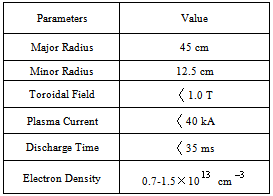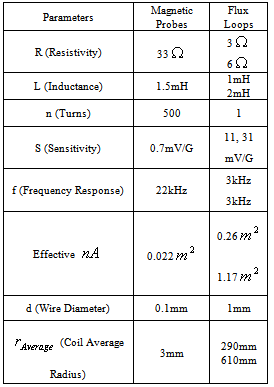| [1] | A. Salar Elahi et al., IEEE Trans. Plasma Science 38 (2), 181-185, (2010), DOI: 10.1109/TPS.2009.2037965 |
| [2] | A. Salar Elahi et al., IEEE Trans. Plasma Science 38 (9), 3163-3167, (2010), DOI: 10.1109/TPS.2010.2066289 |
| [3] | M. Emami, M. Ghoranneviss, A. Salar Elahi and A. Rahimi Rad, J. Plasma Phys. 76 (1), 1-8, (2009), DOI: 10.1017/S0022377809008034 |
| [4] | A. Salar Elahi et al., Fusion Engineering and Design 85, 724–727, (2010), DOI: 10.1016/j.fusengdes.2010.04.034 |
| [5] | A. Salar Elahi et al., Phys. Scripta 80, 045501, (2009), DOI: 10.1088/0031-8949/80/04/045501 |
| [6] | A. Salar Elahi et al., Phys. Scripta 80, 055502, (2009), DOI: 10.1088/0031-8949/80/05/055502 |
| [7] | A. Salar Elahi et al., Phys. Scripta 81 (5), 055501, (2010), DOI: 10.1088/0031-8949/81/05/055501 |
| [8] | A. Salar Elahi et al., Phys. Scripta 82, 025502, (2010), DOI: 10.1088/0031-8949/82/02/025502 |
| [9] | A. Salar Elahi et al., Phys. Scripta 82 (3), 035502, (2010), DOI: 10.1088/0031-8949/82/03/035502 |
| [10] | A. Salar Elahi et al., J. Fusion Energy 28 (4), 346-349, (2009), DOI: 10.1007/s10894-009-9198-x |
| [11] | A. Salar Elahi et al., J. Fusion Energy 28 (4), 416-419, (2009), DOI: 10.1007/s10894-009-9215-0 |
| [12] | A. Salar Elahi et al., J. Fusion Energy 28 (4), 408-411, (2009), DOI: 10.1007/s10894-009-9213-2 |
| [13] | A. Salar Elahi et al., J. Fusion Energy 28 (4), 412-415, (2009), DOI: 10.1007/s10894-009-9214-1 |
| [14] | A. Salar Elahi et al., J. Fusion Energy 28 (4), 394-397, (2009), DOI: 10.1007/s10894-009-9210-5 |
| [15] | A. Salar Elahi et al., J. Fusion Energy 28 (4), 404-407, (2009), DOI: 10.1007/s10894-009-9212-3 |
| [16] | A. Salar Elahi et al., J. Fusion Energy 28 (4), 390-393, (2009), DOI: 10.1007/s10894-009-9208-z |
| [17] | A. Salar Elahi et al., J. Fusion Energy 28 (4), 385-389, (2009), DOI: 10.1007/s10894-009-9207-0 |
| [18] | A. Rahimi Rad, M. Ghoranneviss, M. Emami, and A. Salar Elahi, J. Fusion Energy 28 (4), 420-426, (2009), DOI: 10.1007/s10894-009-9216-z |
| [19] | A. Salar Elahi et al., J. Fusion Energy 29 (1), 1-4, (2010), DOI: 10.1007/s10894-009-9218-x |
| [20] | A. Salar Elahi et al., J. Fusion Energy 29 (1), 22-25, (2010), DOI: 10.1007/s10894-009-9221-2 |
| [21] | A. Salar Elahi et al., J. Fusion Energy 29 (1), 29-31, (2010), DOI: 10.1007/s10894-009-9224-z |
| [22] | A. Salar Elahi et al., J. Fusion Energy 29 (1), 26-28, (2010), DOI: 10.1007/s10894-009-9223-0 |
| [23] | A. Salar Elahi et al., J. Fusion Energy 29 (1), 32-35, (2010), DOI: 10.1007/s10894-009-9227-9 |
| [24] | A. Salar Elahi et al., J. Fusion Energy 29 (1), 36-40, (2010), DOI: 10.1007/s10894-009-9226-x |
| [25] | A. Salar Elahi et al., J. Fusion Energy 29 (1), 62-64, (2010), DOI: 10.1007/s10894-009-9232-z |
| [26] | A. Salar Elahi et al., J. Fusion Energy 29 (1), 76-82, (2010), DOI: 10.1007/s10894-009-9234-x |
| [27] | A. Rahimi Rad, M. Emami, M. Ghoranneviss, A. Salar Elahi, J. Fusion Energy 29 (1), 73-75, (2010), DOI: 10.1007/s10894-009-9236-8 |
| [28] | A. Salar Elahi et al., J. Fusion Energy 29 (1), 83-87, (2010), DOI: 10.1007/s10894-009-9235-9 |
| [29] | A. Salar Elahi et al., J. Fusion Energy 29 (1), 88-93, (2010), DOI: 10.1007/s10894-009-9237-7 |
| [30] | A. Salar Elahi et al., J. Fusion Energy 29 (3), 209-214, (2010), DOI: 10.1007/s10894-009-9260-8 |
| [31] | A. Salar Elahi et al., J. Fusion Energy 29 (3), 232-236, (2010), DOI: 10.1007/s10894-009-9264-4 |
| [32] | A. Salar Elahi et al., J. Fusion Energy 29 (3), 251-255, (2010), DOI: 10.1007/s10894-009-9267-1 |
| [33] | A. Salar Elahi et al., J. Fusion Energy 29 (3), 279-284, (2010), DOI: 10.1007/s10894-010-9275-1 |
| [34] | A. Salar Elahi et al., J. Fusion Energy 29 (5), 467-470, (2010), DOI: 10.1007/s10894-010-9307-x |
| [35] | A. Salar Elahi et al., J. Fusion Energy 29 (5), 461-465, (2010), DOI: 10.1007/s10894-010-9305-z |
| [36] | A. Salar Elahi et al., Brazilian J. of Physics 40 (3), 323-326, (2010). |
| [37] | A. Salar Elahi et al., J. Fusion Energy 30 (2), 116-120, (2011), DOI: 10.1007/s10894-010-9359-y |
| [38] | M.R. Ghanbari, M. Ghoranneviss, A. Salar Elahi et al., Phys. Scripta 83, 055501, (2011), DOI: 10.1088/0031-8949/83/05/055501 |
| [39] | A. Salar Elahi, J of Fusion Energy 30 (6), 477-480, (2011), 477-480, DOI: 10.1007/s10894-011-9408-1 |
| [40] | A. Salar Elahi et al., Fusion Engineering and Design 86, 442–445, (2011), DOI: 10.1016/j.fusengdes.2011.03.121 |
| [41] | A. Salar Elahi et al., J of Fusion Energy 31 (2), 191-194, (2011), DOI: 10.1007/s10894-011-9452-x |
| [42] | M.R. Ghanbari, M. Ghoranneviss, A. Salar Elahi and S. Mohammadi, Radiation Effects & Defects in Solids 166 (10), 789–794, (2011), DOI: 10.1080/10420150.2011.610320 |
| [43] | A. Salar Elahi et al., IEEE Trans. Plasma Science 40 (3), 892-897, (2012), DOI: 10.1109/TPS.2012.2182990 |
| [44] | A. Salar Elahi et al., Accepted for publication in Radiation Effects & Defects in Solids (January 2012), DOI: 10.1080/10420150.2011.650171 |
| [45] | Z. Goodarzi, M. Ghoranneviss and A. Salar Elahi, Accepted for the publication in J Fusion Energy (March 2012), DOI: 10.1007/s10894-012-9526-4 |
| [46] | M.R. Ghanbari, M. Ghoranneviss, A. Salar Elahi et al., Phys. Scripta 85 (5), 055502, (2012), DOI: 10.1088/0031-8949/85/05/055502 |
| [47] | M. Ghoranneviss, A. Salar Elahi, H. Hora, G.H. Miley et al., Accepted for the publication in Laser and Particle Beams (May 2012), DOI: 10.1017/S0263034612000341 |
| [48] | M. Ghoranneviss et al., Accepted for the publication in Radiation Effects and Defects in Solids (June 2012) |
| [49] | A. Salar Elahi et al., Accepted for the publication in Radiation Effects and Defects in Solids (June 2012), DOI: 10.1080/10420150.2012.706609 |
| [50] | A. Salar Elahi et al., Accepted for the publication in Radiation Effects and Defects in Solids (June 2012), DOI: 10.1080/10420150.2012.706607 |
| [51] | K. Mikaili, M. Ghoranneviss, A. Salar Elahi et al., Accepted for the publication in J Fusion Energy (July 2012), DOI: 10.1007/s10894-012-9563-z |
| [52] | A. Salar Elahi et al., Journal of Nuclear and Particle Physics 1(1), (2011), 10-15, DOI: 10.5923/j.jnpp.20110101.03 |
| [53] | A. Salar Elahi et al., Journal of Nuclear and Particle Physics 2(2), (2012), 1-5, DOI: 10.5923/j.jnpp.20120202.01 |
| [54] | M. Ghasemloo, M. Ghoranneviss, A. Salar Elahi et al., Journal of Nuclear and Particle Physics 2(2), (2012), 22-25, DOI: DOI: 10.5923/j.jnpp.20120202.05 |

 , where
, where  represent to magnetic poloidal flux. In the ohmically heated tokamaks, ohmic coils field is the main fraction of poloidal flux which passing through the flux loop. Therefore to obtain net poloidal flux due to plasma, compensation will require for all excessive flux. Because of large area of the flux loop, the inductive voltage is also large and then it consists of usually one turn. According to relation for frequency response, it is obvious that because of small self inductance, frequency response of flux loop usually is higher than which desired.Although magnetic probe suitable for measurement of plasma position only in circular cross section plasma and not for elongated one, but the flux loop either in elongated and or circular cross section tokamaks can be used. Therefore we used these two techniques for the IR-T1 tokamak with circular cross section.The plasma boundary is usually defined by Last Closed Flux Surface (LCFS). In the LCFS poloidal magnetic flux is constant, if we install some flux loops at some distance in vicinity of LCFS, then we can find plasma displacement from difference in poloidal fluxes that received with flux loops according to Shafranov equation. In the quasi-cylindrical coordinates
represent to magnetic poloidal flux. In the ohmically heated tokamaks, ohmic coils field is the main fraction of poloidal flux which passing through the flux loop. Therefore to obtain net poloidal flux due to plasma, compensation will require for all excessive flux. Because of large area of the flux loop, the inductive voltage is also large and then it consists of usually one turn. According to relation for frequency response, it is obvious that because of small self inductance, frequency response of flux loop usually is higher than which desired.Although magnetic probe suitable for measurement of plasma position only in circular cross section plasma and not for elongated one, but the flux loop either in elongated and or circular cross section tokamaks can be used. Therefore we used these two techniques for the IR-T1 tokamak with circular cross section.The plasma boundary is usually defined by Last Closed Flux Surface (LCFS). In the LCFS poloidal magnetic flux is constant, if we install some flux loops at some distance in vicinity of LCFS, then we can find plasma displacement from difference in poloidal fluxes that received with flux loops according to Shafranov equation. In the quasi-cylindrical coordinates  for the poloidal magnetic flux we have [1].
for the poloidal magnetic flux we have [1]. where
where 
 are the plasma current, major and minor plasma radiuses, poloidal beta and internal inductance of the plasma. The relationship between poloidal magnetic flux and plasma displacement is:
are the plasma current, major and minor plasma radiuses, poloidal beta and internal inductance of the plasma. The relationship between poloidal magnetic flux and plasma displacement is:

 and
and  are the poloidal flux which obtained with outer and inner flux loops,
are the poloidal flux which obtained with outer and inner flux loops,  and
and  are the average magnetic fields between outer and inner flux loops and the plasma surface respectively which can be obtained from magnetic probe,
are the average magnetic fields between outer and inner flux loops and the plasma surface respectively which can be obtained from magnetic probe,  is the intervening area for each loop defined as:
is the intervening area for each loop defined as:  which d is distance between LCFS and each loop and
which d is distance between LCFS and each loop and  is the distance between the midpoint (d/2) and center of the facility. In the IR-T1 tokamak two poloidal flux loops designed and installed on outer surface of vacuum chamber in polar angles
is the distance between the midpoint (d/2) and center of the facility. In the IR-T1 tokamak two poloidal flux loops designed and installed on outer surface of vacuum chamber in polar angles  and
and  , with radiuses
, with radiuses  and
and  (see Figure (1) and Table (2)).
(see Figure (1) and Table (2)). 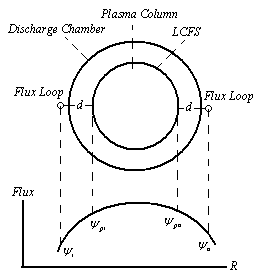
 , and
, and  ) in different order in
) in different order in  (flux function). In this section, we regarded quadratic order (which proposed by Guazzotto [3]), and examined on the IR-T1.The GSE is:
(flux function). In this section, we regarded quadratic order (which proposed by Guazzotto [3]), and examined on the IR-T1.The GSE is:
 as [3]:
as [3]:
 are the values of
are the values of  , p, and F on magnetic surfaces axis,
, p, and F on magnetic surfaces axis,  is the major radius, and
is the major radius, and  is the vacuum toroidal field.The Grad-Shafranov equation reduces to:
is the vacuum toroidal field.The Grad-Shafranov equation reduces to:
 . With normalizing variables as
. With normalizing variables as  , and
, and  , Eq. (6) can then be written as:
, Eq. (6) can then be written as:
 , is the inverse aspect ratio, and
, is the inverse aspect ratio, and
 can be written as:
can be written as:
 , and for up-down symmetric case,
, and for up-down symmetric case,  obtained as:
obtained as:
 can be written as:
can be written as:
 ,
,  , and
, and  are the Whittaker functions, and in this model
are the Whittaker functions, and in this model  . Guazzotto proposed only three terms for m, and then
. Guazzotto proposed only three terms for m, and then  can be written as:
can be written as:
 ,
,  , and
, and  are nine unknown coefficients which must be determined. The first six of them can be obtained from boundary conditions. The boundary conditions for the points of inner, outer, and top of the plasma cross section are (see Figure (2)):
are nine unknown coefficients which must be determined. The first six of them can be obtained from boundary conditions. The boundary conditions for the points of inner, outer, and top of the plasma cross section are (see Figure (2)):

 ) and the other the normalization for
) and the other the normalization for  on magnetic axis:
on magnetic axis:

 ).But for other three coefficients, by setting
).But for other three coefficients, by setting  (the simplest solution for GSE independent of Z), and introduce one approximate value for the
(the simplest solution for GSE independent of Z), and introduce one approximate value for the  (
( , negative for diamagnetism plasma), and assuming that
, negative for diamagnetism plasma), and assuming that  be imaginary and
be imaginary and  be real, the values of
be real, the values of  can be determined by minimizing the error function between traditional plasma shape (
can be determined by minimizing the error function between traditional plasma shape ( ), and analytical plasma shape. Appropriate error function between them defined as follow:
), and analytical plasma shape. Appropriate error function between them defined as follow: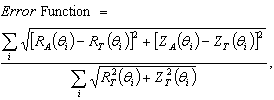
 ) for our purpose (circular plasma).In general by minimizing the error function (e.g. by Mathematica) as possible to zero, and finding optimal values for
) for our purpose (circular plasma).In general by minimizing the error function (e.g. by Mathematica) as possible to zero, and finding optimal values for  , and also solving seven equations for the boundary conditions (Eqs. (13), (14), (15)), six unknown coefficients (
, and also solving seven equations for the boundary conditions (Eqs. (13), (14), (15)), six unknown coefficients ( ), moreover
), moreover  can be find. Therefore the magnetic flux surfaces can be plot by substituting these nine coefficients and also input parameters as
can be find. Therefore the magnetic flux surfaces can be plot by substituting these nine coefficients and also input parameters as  , and
, and  in Eq. (12). Moreover the Shafranov shift (
in Eq. (12). Moreover the Shafranov shift ( ), is also can be obtained by subtracting
), is also can be obtained by subtracting  from
from . We repeat 18 times this procedure for different approximate values for
. We repeat 18 times this procedure for different approximate values for  during time interval of target shot (for example the magnetic flux surfaces at t=15ms correspond to
during time interval of target shot (for example the magnetic flux surfaces at t=15ms correspond to  shown in Figure (3)), and obtaining time interval of Shafranov shift. Results were shown in Figure (4).
shown in Figure (3)), and obtaining time interval of Shafranov shift. Results were shown in Figure (4). is given by:
is given by:
 is the inductive voltage supplied by the flux loops and each one of the magnetic probes, which were placed around the IR-T1 tokamak vacuum chamber.
is the inductive voltage supplied by the flux loops and each one of the magnetic probes, which were placed around the IR-T1 tokamak vacuum chamber. 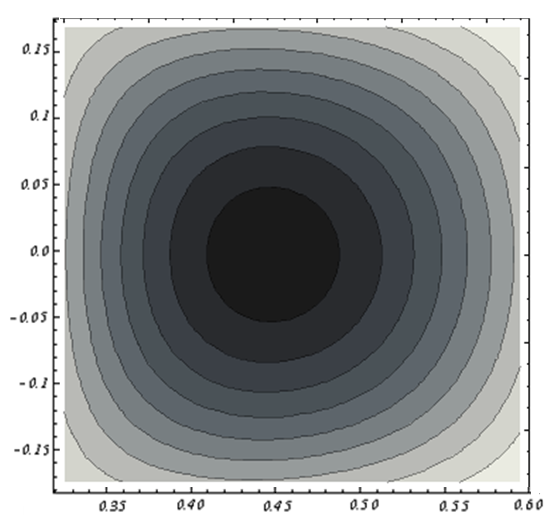
 on IR-T1 Tokamak, Displacement of the Plasma Column Center observable
on IR-T1 Tokamak, Displacement of the Plasma Column Center observable
 is also presented, and experimented on IR-T1. Results show that two methods are in good agreement with each other. The acceptable differences between them are because of (1) approximation in measurement of poloidal flux on LCFS, (2) the approximate values chosen for
is also presented, and experimented on IR-T1. Results show that two methods are in good agreement with each other. The acceptable differences between them are because of (1) approximation in measurement of poloidal flux on LCFS, (2) the approximate values chosen for , and (3) the errors do not become zero during minimizing the error function.
, and (3) the errors do not become zero during minimizing the error function. Abstract
Abstract Reference
Reference Full-Text PDF
Full-Text PDF Full-Text HTML
Full-Text HTML